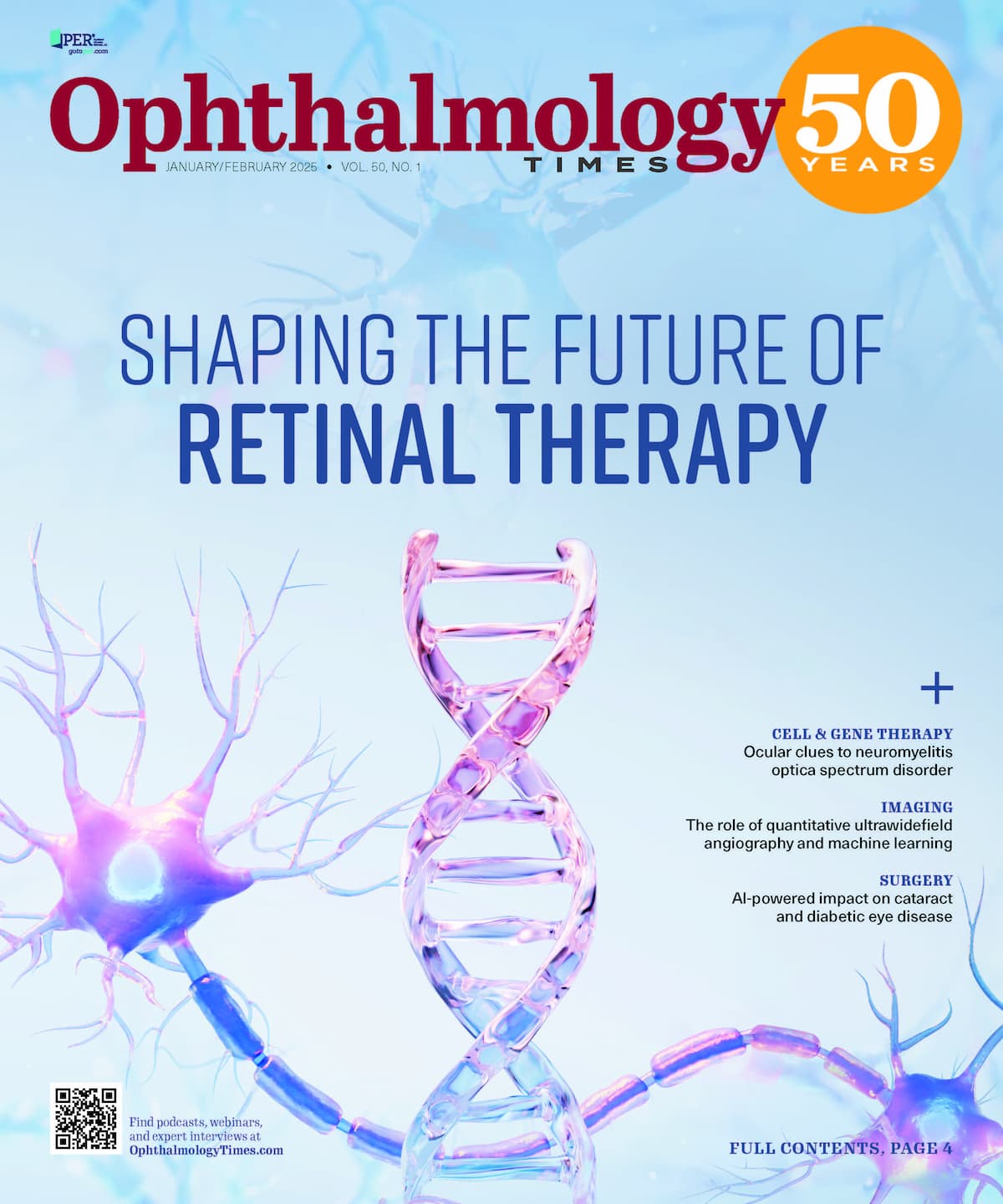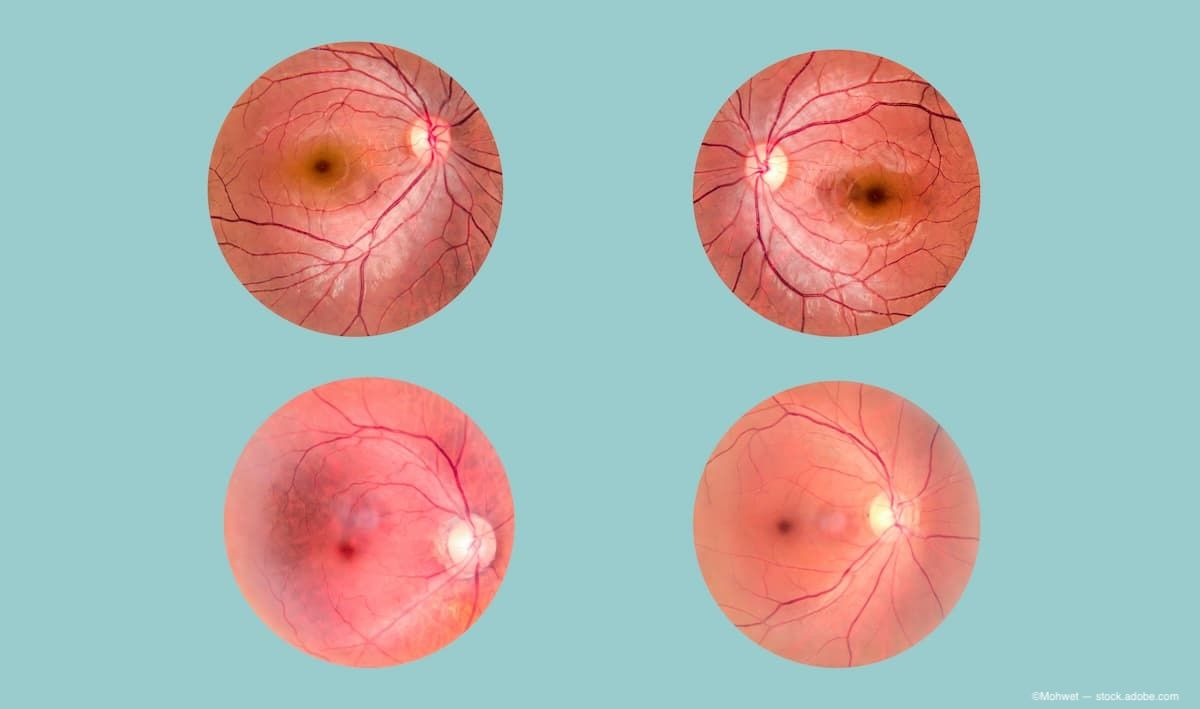Publication
Article
Digital Edition
Shaping the future of retinal therapy
Key Takeaways
- Anti-VEGF agents have improved retina care but require frequent injections, posing challenges for patients with comorbidities.
- Tyrosine kinase inhibitors (TKIs) like axitinib and vorolanib are in phase 3 trials, aiming to extend treatment intervals.
Advancements in drug durability and patient care are closing treatment gaps.
Vink Fan - stock.adobe.com (Modified by Jennifer Toomey)

The introduction of anti-VEGF agents has revolutionized the field of medical retina care by reducing rates of vision loss and improving clinicians’ ability to treat a variety of diseases. Even with this progress, significant gaps remain, especially regarding treatment durability.
Anti-VEGF drugs require frequent intravitreal injections. Understandably, it can be difficult for patients to come into the office for these treatments due to the time commitments and financial costs they can impose. Additionally, many patients who require treatment for retinal diseases may be older or have significant comorbidities that make navigating these demands more difficult.1
Although newer agents have been developed with extended treatment intervals up to every 3 or 4 months,2 clinicians still observe poorer outcomes in real-world settings compared to clinical trials due to challenges with patient adherence and undertreatment.3 To address these unmet needs, a variety of innovative approaches are being investigated that seek to increase the drug durability and reduce the treatment burden for these patients.
Tyrosine kinase inhibitors
One approach to increasing treatment durability comes in the form of tyrosine kinase inhibitors (TKIs). TKIs are small-molecule drugs that act as pan-VEGF blockers. Whereas more traditional
anti-VEGF drugs target and block circulating VEGF proteins such as VEGF-A or VEGF-C, TKIs work intracellularly, binding directly to the VEGF receptor sites to stabilize disease activity.4
Currently, TKIs are being investigated as maintenance therapy and most are being used in conjunction with a sustained-release delivery system. Two TKIs that show promise for the treatment of retinal disease are axitinib (Axpaxli; Ocular Therapeutix) and vorolanib (Duravyu; EyePoint Pharmaceuticals). Two programs are in phase 3 trials.
A bioresorbable hydrogel implant that incorporates axitinib is being studied for neovascular age-related macular degeneration (nAMD) in the SOL-1 trial (NCT06223958) and the SOL-R phase 3 trial (NCT06495918), in which it is being compared with aflibercept injection for safety and durability and the potential of redosing every 6 months, respectively.5
This implant is also being studied in the HELIOS phase 1 trial (NCT05695417) for diabetic retinopathy, which presented positive 48-week data at the 2024 American Society of Retina Specialists 42nd Annual Meeting in Stockholm, Sweden.6
These data are intriguing because in diabetic retinopathy, many retina specialists do not currently treat patients with frequent injections even though there is an FDA approval for this indication. As most of these patients have good visual acuity, giving them a high treatment burden is not warranted until they reach vision-threatening complications. However, the potential to provide 1 or 2 injections a year to maintain or improve diabetic retinopathy severity and avoid vision-threatening complications may be an area where TKIs can be impactful. An investigational sustained-release delivery therapy administering vorolanib is being studied for nAMD in the phase 3 LUCIA (NCT06683742) and LUGANO (NCT06668064) studies, which aim to show noninferiority to bimonthly aflibercept injection, with dosing every 6 months.7
In my practice, I envision TKIs as being most helpful for patients who already have stability to extend their dosing and reduce their treatment burden. However, these studies are ongoing, so we have to wait for efficacy and safety data to emerge before determining how best to use these TKI implants. These are trials that I will be watching closely, and I look forward to the results.
Gene therapy
Unlike gene therapy for inherited retinal diseases, which seeks to replace a missing or damaged gene segment, gene therapy for more common retinal diseases typically involves using adeno-associated virus (AAV) vectors to deliver the transgene for a therapeutic molecule into the retina, with the hope that this will allow for a single-injection treatment and sustained antibody delivery.
One approach that has shown promise is RGX-314 (ABBV-RGX-314; AbbVie, REGENXBIO), which uses an AAV8 vector to encode a ranibizumab-like anti-VEGF monoclonal antibody fragment in the retina. Subretinal delivery of RGX-314 is currently being studied for the treatment of nAMD in the phase 2b/3 ATMOSPHERE trial (NCT04704921) and phase 3 ASCENT trial (NCT05407636). RGX-314 is also being studied via suprachoroidal delivery for the treatment of nAMD in the phase 2 AAVIATE trial (NCT04514653). AAVIATE has announced promising interim data, with reductions of 80% in the annualized injection rate and 50% in the injection-free rate through 6 months in one cohort. RGX-314 was also found to have a manageable safety profile in AAVIATE, with no drug-related serious adverse events occurring across participant groups.8 However, in the trials investigating subretinal delivery of RGX-314, asymptomatic dose-dependent pigmentary changes were observed in patients’ peripheral retina several months after subretinal injection.9 Although these changes do not affect protein production, we are monitoring and watching these changes as these therapies are studied further.
Other gene therapies on the horizon include ixoberogene soroparvovec (Adverum Biotechnologies), which uses an AAV2.7m8 vector to efficiently deliver and express aflibercept, and 4D150 (4D Molecular Therapeutics), which uses the R100 vector to deliver both aflibercept and a VEGF-C inhibitory RNA interference.10,11
Neuroprotection
In many ways, neuroprotection is the holy grail of retinal disease management. It is frustrating to see patients lose vision over time knowing that if there were a treatment that could prevent cell death or slow disease progression, we could make a meaningful outcome for them. However, achieving and demonstrating neuroprotection in retinal disease is no easy task.
Attempts at neuroprotection have shown significant promise in the treatment of macular telangiectasia type 2 (MacTel). MacTel is a bilateral, progressive, neurodegenerative condition in which dysfunction of the Müller cells—glial cells that surround retinal neurons—leads to atrophy and irreversible central vision loss.12
The results of 2 phase 3 randomized controlled trials found that the use of ciliary neurotrophic factor (CNTF) preserved photoreceptors in these patients, as measured by ellipsoid zone (EZ) loss. In the NTMT-03-A (NCT03316300) and NTMT-03-B (NCT03319849) trials, patients with MacTel were randomly assigned 1:1 to receive either NT-501 (Neurotech Pharmaceuticals), an encap‑
sulated cell therapy implant containing genetically modified retinal pigment epithelium cells that express CNTF, or sham therapy.
Patients who received NT-501 in NTMT-03-A and NTMT-03-B demonstrated reductions in EZ loss of 55% and 31%, respectively, through 2 years compared to baseline.13 These results are particularly exciting because there has been no therapy for this disease to date and it can be devastating for those affected, causing them to lose their vision and independence while still in their working years. NT-501 has been studied for over a decade—including for other conditions such as nAMD and geographic atrophy—and has been shown to be generally well tolerated.14,15 NT-501 is currently under review for MacTel type 2 by the FDA, with a Prescription Drug User Fee Act date of March 18, 2025.
Conclusions
New approaches are emerging that offer promise to close treatment gaps. It is an exciting time for retinal physicians and their patients, and it will be interesting to follow these advances and see how they can continue to reshape the practice landscape and help us offer the best care to our patients.
Note: This article provides an overview of some of the many recent advancements in retinal research and therapies at the time of publication. It is not an exhaustive list of approved or emerging options.
Arshad M. Khanani, MD, MA, FASRS
E: arshad.khanani@gmail.com
Khanani is a managing partner, director of clinical research, and director of fellowship at Sierra Eye Associates in Reno, Nevada, and a clinical professor at the University of Nevada, Reno School of Medicine. He has reported serving as a consultant for 4D Molecular Therapeutics, Adverum Biotechnologies, Clearside Biomedical, EyePoint Pharmaceuticals, Neurotech Pharmaceuticals, Ocular Therapeutix, and RegenxBio.
References:
Shahzad H, Mahmood S, McGee S, et al. Non-adherence and non-persistence to intravitreal anti-vascular endothelial growth factor (anti-VEGF) therapy: a systematic review and meta-analysis. Syst Rev. 2023;12(1):92. doi:10.1186/s13643-023-02261-x
Xu M, Fan R, Fan X, Shao Y, Li X. Progress and challenges of anti-VEGF agents and their sustained-release strategies for retinal angiogenesis. Drug Des Devel Ther. 2022;16:3241-3262. doi:10.2147/DDDT.S383101
Ciulla TA, Huang F, Westby K, Williams DF, Zaveri S, Patel SC. Real-world outcomes of anti-vascular endothelial growth factor therapy in neovascular age-related macular degeneration in the United States. Ophthalmol Retina. 2018;2(7):645-653. doi:10.1016/j.oret.2018.01.006
Hussain RM, Shaukat BA, Ciulla LM, Berrocal AM, Sridhar J. Vascular endothelial growth factor antagonists: promising players in the treatment of neovascular age-related macular degeneration. Drug Des Devel Ther. 2021;15:2653-2665. doi:10.2147/DDDT.S295223
Harp MD. Ocular Therapeutix enrolls first patient in phase 3 SOL-R clinical trial for wet AMD. Ophthalmology Times. July 30, 2024. Accessed November 25, 2024. https://www.ophthalmologytimes.com/view/ocular-therapeutix-enrolls-first-patient-in-phase-3-sol-r-clinical-trial-for-wet-amd
Hutton D. Ocular Therapeutix announces positive topline phase 1 data for Axpaxli in diabetic retinopathy. Modern Retina®. April 19, 2024. Accessed November 25, 2024. https://www.modernretina.com/view/ocular-therapeutix-announces-positive-topline-phase-1-data-for-axpaxli-in-diabetic-retinopathy
Hutton D. EyePoint Pharmaceuticals announces first patient dosed in global phase 3 LUGANO clinical trial of Duravyu for wet AMD. Ophthalmology Times. October 24, 2024. Accessed November 25, 2024. https://www.ophthalmologytimes.com/view/eyepoint-pharmaceuticals-announces-first-patient-dosed-in-global-phase-3-lugano-clinical-trial-of-duravyu-for-wet-amd
Rowe LW, Ciulla TA. Gene therapy for non-hereditary retinal disease: age-related macular degeneration, diabetic retinopathy, and beyond. Genes (Basel). 2024;15(6):720. doi:10.3390/genes15060720
Campochiaro PA, Avery R, Brown DM, et al. Gene therapy for neovascular age-related macular degeneration by subretinal delivery of RGX-314: a phase 1/2a dose-escalation study. Lancet. 2024;403(10436):1563-1573. doi:10.1016/S0140-6736(24)00310-6
Khanani AM, Boyer DS, Wykoff CC, et al. Safety and efficacy of ixoberogene soroparvovec in neovascular age-related macular degeneration in the United States (OPTIC): a prospective, two-year, multicentre phase 1 study. EClinicalMedicine. 2023;67:102394. doi:10.1016/j.eclinm.2023.102394
Khanani AM. Update on gene therapy for neovascular AMD. Presented at: 24th Euretina Congress; September 19-22, 2024; Barcelona, Spain.
Kedarisetti KC, Narayanan R, Stewart MW, Reddy Gurram N, Khanani AM. Macular telangiectasia type 2: a comprehensive review. Clin Ophthalmol. 2022;16:3297-3309. doi:10.2147/OPTH.S373538
DeFino A. Macular telangiectasia cell therapy meets primary endpoints in phase 3 trials. Healio. January 18, 2024. Accessed January 6, 2025. https://www.healio.com/news/ophthalmology/20240118/macular-telangiectasia-cell-therapy-meets-primary-end point-in-phase-3-trial
Chew EY, Clemons TE, Peto T, et al; MacTel-CNTF Research Group. Ciliary neurotrophic factor for macular telangiectasia type 2: results from a phase 1 safety trial. Am J Ophthalmol. 2015;159(4):659-666.e1. doi:10.1016/j.ajo.2014.12.013
Guerrero-Naranjo JL, Quiroz-Mercado H, Sanchez-Bermudez G, et al. Safety of implantation of the NT-503 device in patients with choroidal neovascularization secondary to age-related macular degeneration. Abstract presented at: Association for Research in Vision and Ophthalmology Annual Meeting; May 5-9, 2013; Seattle, WA. Abstract 3298.

Newsletter
Don’t miss out—get Ophthalmology Times updates on the latest clinical advancements and expert interviews, straight to your inbox.




